 The bowline is referred to as the “King of the Knots,” and with good reason. It is easy to tie, resists jamming, and retains rope strength decently. Tying the bowline with a bight at the end is a convenient way to make an exploding knot—one that unties with a simple tug on the free end. I was pleasantly surprised to learn of a new knot, which dimview.org calls a “Kalmyk Loop (калмыцкий узел)”.
The bowline is referred to as the “King of the Knots,” and with good reason. It is easy to tie, resists jamming, and retains rope strength decently. Tying the bowline with a bight at the end is a convenient way to make an exploding knot—one that unties with a simple tug on the free end. I was pleasantly surprised to learn of a new knot, which dimview.org calls a “Kalmyk Loop (калмыцкий узел)”.
The Kalmyk Loop
The following three images and video (dimview.org) are just about all of the information I could find on this knot on the Internet. I assume it is not (pun intended) in Ashley’s Book of Knots or else it would be more well known.
From dimview.org
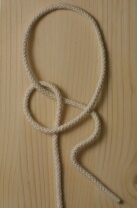
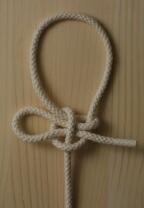
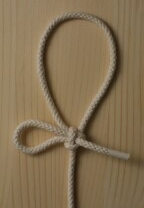 http://blog.iharder.net/wp-content/uploads/2011/04/kalmyk-loop-poster.mov
http://blog.iharder.net/wp-content/uploads/2011/04/kalmyk-loop-poster.mov
The author of the other website mentions a book called Скрягин Л. Н. Морские узлы by Lev Skryagin. Google translates the title for me as “Skryagin LN Marine units.” Maybe this is the Russian equivalent to Ashley’s Book of Knots. I found a PDF copy of the Russian book, and I found the knot on page 79 (80 of the PDF):
I studied the pictures and the video and learned three ways to tie the knot. It is a beautiful knot. As an exploding knot it, it beats the bowline with a bight by untying more cleanly. You can see it untying in the video. Here are two pictures I took of the kalmyk, before and after exploding.

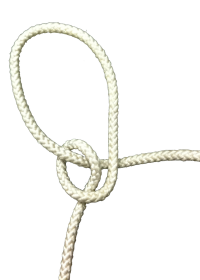
The Kalmyk Loop before and after “exploding” by pulling on free end.
Kalmyk Compared to Bowline
The kalmyk and bowline (with a bight) knots have similar features, but I think the kalmyk is more elegant. Here are the two side by side:

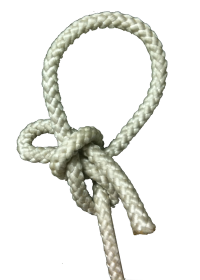
The kalmyk (left) and the bowline with a bight (right).
Here are the two knots after they have been exploded. They look similar, but the kalmyk wins. When you pull on the standing end of the kalmyk to pull the loop off its anchor, it pulls free. When you pull the standing end from a bowline, the rope tightens on itself. This has always bothered me about the bowline, but it was the best I had (until now).

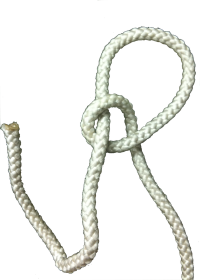
The exploded kalmyk (left) and the bowline with a bight (right).
Notice how the kalmyk standing end, when pulled, wants to move down, along, and off the free end. When the bowline standing end is pulled, it wants to pull against and tighten the loop it has formed around the free end, similar to the effective function of a sheep shank.
Kalmyk Compared to Mooring Hitch
I had the idea that the kalmyk might be a mooring hitch. It is not, but they also share similar traits. Look at these two pictures of them side by side:


The kalmyk (left) and the mooring hitch (right).
If you look closely, you can see that the mooring hitch is in fact an adjustable loop—a slip knot. In case you did not know how cool the mooring hitch is, though, look at how the mooring hitch, when exploded, completely separates the standing end from the free end:

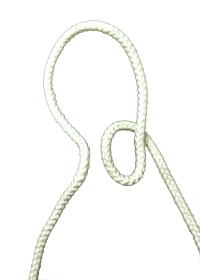
The exploded kalmyk (left) and the mooring hitch (right).
Tying the Kalmyk
Since the other website did not have step by step tying instructions, I thought I had better provide some.
Conclusion
This kalmyk loop amazes me, both in its function and in its secrecy. How can this knot not be known? I have two theories:
- Could the knot be fatally flawed; that is why no one talks about it. That could be, and I would like to know if the knot does in fact have a fatal design flaw, but there are plenty of “fatally flawed” knots in Ashley’s Book of Knots that we are all taught anyway (like the square/reef knot). This brings me to my second theory.
- The knot is not in Ashley’s Book of Knots; that is why no one talks about it. I do not have the book to verify this, but I suspect it simply did not make it into the book, and so the western world never learned of it.
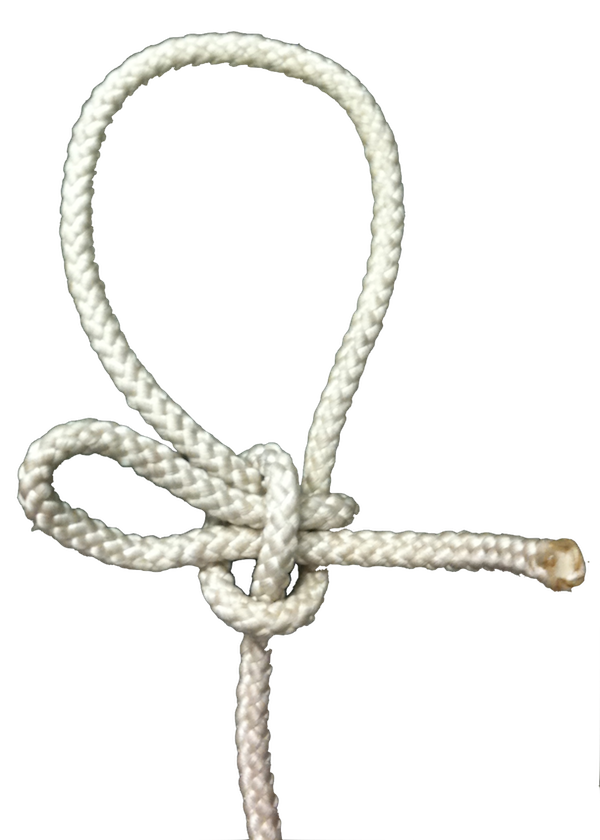
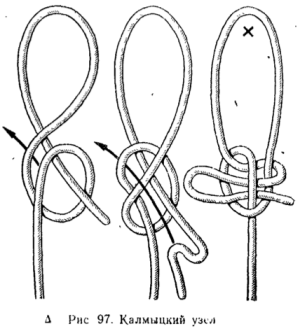




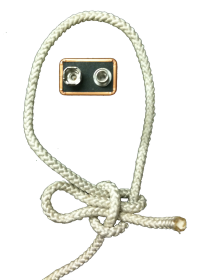
It is a very interesting knot. The only flaw that I have seen while using it is that unless it is properly dressed and tightened, the standing end will sometimes collapse on the loop and seize under strain. It then becomes very difficult to pull the loop out. Also, if the loop and end are not long enough, they can pull through when the standing end collapses and the knot will fail.
This “knot”, i.e. slipped loop, can be improved by “locking”, with the bitter end passed through the bight of the loop which allows the kalmyk loop, aka eskimo bowline, to “explode”; that secondary loop is in turn tighted when the knot is formed.
@jdmccubbin I’m trying to picture this but without the benefit of any rope handy. Could you take a picture of such a knot and post a link here?
Hi Robert! Here in Russia we have Kossak Knot as well. The same as Kalmyk but without the bight (not quick release variant of Kalmyk). I’m quite sure that Kossak CAN decrown the crowned Bowline. ))
This is a great knot and quick to tie. Like the bowline and the Mooring Hitch, it’s based on the sheet bend. Tie it without the slip to see this.
Thanks for the very clear diagrams.
Always appreciate the time folks take to share information like this so, thank you! I’ve been searching for a exploding fixed loop for some time and after finding this, I have used it on several occasions around camp. I’ve always found it to be secure and a breeze to undo. I have tested this knot up to 200lbs with 550 paracord and it held up beautifully. Above this weight with this particular rope though, I don’t know its limits. I’d reiterate as has already been stated here that dressing this knot snugly prior to load bearing is very important to prevent collapsing.
This is a slipped version of the Eskimo Bowline.
@Morten J
Eskimo Bowline is new to me. The pictures Google turns up look a bit different, but I’ll have to study it. Thanks!
You will see this loop (unslipped version) make a cameo appearance in the movie Sometimes a Great Notion by Paul Newman using it to tow a bundle of logs down river. It is also called an Eskimo bowline, as was mentioned in an earlier comment. Not sure if it has a name in logging. The difference in performance from a traditional bowline is this is tied when ring loading is present (forces potentially expanding the loop), rather than a straight pull on the rope.
It’s very cool to see the slipped variation is called a Kalmyk, and yes it does make more sense to use this variation because of the ease of release after pulling the slip free.
@joe Thanks for the extra info. I didn’t know it did well on expanding (or that it was called ring loading). I’ve found the Kalmyk is harder to untie than the bowline after a heavy loading, but if I’m not expecting a heavy loading—like with tying down tents and other general bush craft—I love it.
I’m glad to learn more about it, and now I’ll have to netflix the Newman flick.
I am reading the book “On the Trail of Genghis Khan” by Tim Cope. He traveled for 3 years on horseback from Mongolia to Hungary. On page 437 he mentions a knot he describes as a reverse bowline. On his very first night he was taught this knot by a Mongolian herder. As he traveled across the Eurasian Steppe he found the same knot but with the name of the peoples who lived in the area. A Kazakh knot in Kazakhstan, Kalmyk knot for the Kalmyk people, and in Hungary it was called a Cumanian knot. He used this knot for everything
I’m reading the same book and wanted to find the knot too. Thanks for adding this comment as that was how Google found it – I searched on Cumanian 🙂
@bill mollenhauer
I wonder if that’s this knot or maybe the Eskimo Bowline mentioned above. After having used the bowline and now the Kalmyk for years, I have learned NOT to use the Kalmyk if the knot will be under heavy loading. It becomes very hard to untie. Fortunately “heavy loading” is not the majority of my knot tying, so this Kalmyk has been a real blessing.
Russian sliding Bulin (Kalmyk knot), which allows you to pick up the rope after descending it:
It’s possible to pull the knot apart by ring-loading – pulling on both sides of the loops against the knot. The captured bend can slip it’s way out and the knot just comes apart